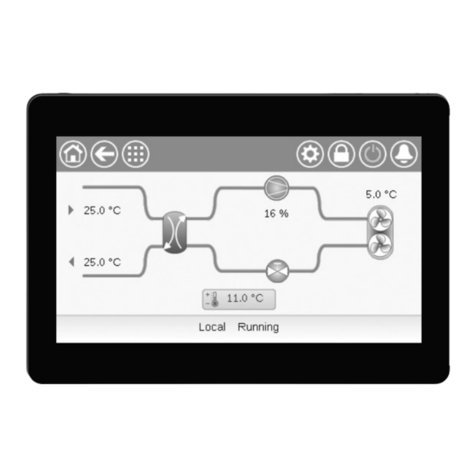
4.4 - Menu screen characteristics
\\MAINMENU Current path in the menu structure
GENUNIT PUMPSTAT Selection cursor to the left of the
first column
TEMP RUNTIME
PRESSURE MODES Menu list
SETPOINT LANGUAGE
INPUTS LOGOUT
OUTPUTS
General Parameters Menu Description of the menu framed by
the selection cursor
Each menu item denes the access to categorised data. The
Up and Down arrows position the cursor at the current item.
The Enter key activates the display of the selected sub-menu.
The item LOGOUT permits exiting from the menu screen and
protects access by a user password. The “Previous” key per-
mits exiting from the current screen without deactivating the
password-protected access.
4.5 - Data screen or configurable parameter
characteristics
The data screens display information parameters such as tem-
peratures or pressures. The conguration screens display unit
control parameters such as the water temperature setpoints.
\\MAINMENU\TEMP Current path in the menu structure
EWT 12.0°C List of items
LWT 7.0°C Cursor position
OAT 35.0°C
CHWSTEMP -17.8°C
SCT_A 57.0°C
Leaving Water Temperature Description of the item framed by
the selection cursor
The Up and Down arrow keys position the cursor on the current
menu item. The Enter key activates the parameter modication
(if possible). Any non-pertinent modication attempt is blocked
by a refusal screen.
4 - SETTING UP PRO-DIALOG+ CONTROL
4.1 - General features
The interface includes different screens that are listed below:
• Default screens with direct display of the main parameters,
• Menu screens for navigation,
• Data/conguration screens listing the parameters by type,
• Operating mode selection screen,
• Password entry screen,
• Parameter modication screen.
4.2 - Default screen characteristics
There are four default screens. Each screen shows:
• The unit status, its screen number,
• Three displayed parameters.
LOCAL OFF 1 On the left the unit status, on the right
the screen number
Entering water temp Description of the first parameter
EWT 17.2 °C Abbreviation and value with unit of
measurement of the first parameter
Leaving water temp Description of the second parameter
LWT 17.2 °C Abbreviation and value with unit of
measurement of the second parameter
Outside air temperature Description of the third parameter
OAT 21.7 °C Abbreviation and value with unit of
measurement of the third parameter
Pressing the Up or Down key changes one default screen to
another default screen. The screen number is updated.
4.3 - Password screens
Enter password Description of the password entry
screen
0_** Password value
(0 = basic access) Description
The password is entered digit by digit. The cursor is shown at the
current digit that ashes. The arrow keys modify the digit value.
The digit modication is validated with the Enter key and the cur-
sor is moved to the next digit.
Enter password
1_** The first digit is 1, the cursor is
positioned on the second digit
(0 = basic access)
Enter password
11_**
(0 = basic access)
Pressing the Enter key at a digit without value validates the
overall selection of the password. The screen is refreshed by
the menu list, and the items displayed depend on the level of
the activated password. The entry of an incorrect password
keeps the password entry screen.
Password selection 0 (zero) can simply be made by pressing
the Enter key twice in succession.
NOTE: If the interface is not used for a long period, it will go
black. The control is always active, the operating mode
remains unchanged. The interface screen is re-animated,
when the user presses a key. Pressing the key once illumi-
nates the screen, pressing the key a second time leads to a
screen that is related to the context and the key symbol.
EREBAACCESS EN - 6





























